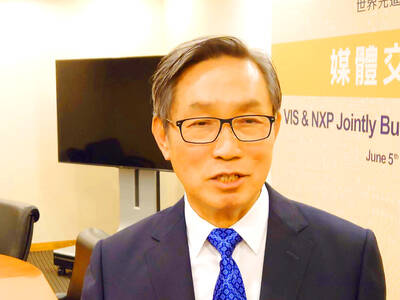A milestone move by the European Central Bank (ECB) toward launching a digital euro within a few years means the time has come for the newest incarnation of money to prove its worth.
A few countries have introduced central bank digital currencies (CBDCs). China is trialling a prototype yuan with 200 million users, India is gearing up for a pilot and about 130 countries representing 98 percent of the global economy are exploring digital cash.
The ECB’s move on Wednesday to establish a pilot that could lead to a digital currency for the 20 countries that use the common currency, making it the first heavyweight Western central bank to formally forge ahead, could become a global blueprint.

Photo: Reuters
Supporters say CBDCs would modernize payments with new functionality and provide an alternative to physical cash, which seems in terminal decline.
However, there are still questions about why CBDCs represent an advance, with uptake low in countries that have adopted them, such as Nigeria, as well as protests against the ECB’s plans, showing public concern about snooping.
Commercial bankers fret about the costs and possible deposit bleeds as customers could move money into central bank accounts, while developing countries worry that an easily accessible digital dollar, euro or yuan could cause havoc in their systems.
The ECB’s plan “is a very big deal, and a lot of the rest of the world is watching this closely,” said Josh Lipsky, senior director of the Atlantic Council’s GeoEconomics Center.
“It is one of the biggest central banks, so if it comes up with answers to the privacy and cybersecurity issues and the ability to use it offline, it will be very influential,” he said.
Central banks were spooked into action five years ago when Facebook floated plans for a breakaway currency, but policymakers have yet to fully persuade many why CBDCs are needed.
Fabio Panetta, the ECB Executive Board member overseeing the bank’s digital euro work, said it would help “future-proof” the currency and reduce what he called an over-reliance on the payment systems of US-based credit cards.
Yet experts are scratching their heads.
“It’s not yet clear what the thing is that could be done with a retail CBDC that couldn’t also be replicated with commercial bank money,” said Barclays PLC managing director of advanced technologies Lee Braine, who has been involved in some of the Bank of England’s digital pound projects.
“You are potentially breaking some of the singleness of money,” he said, flagging the risk of a two-tier system if CBDCs are allowed different functionality or data disclosure rules than bank accounts.
“This all comes down to, what is money?” he said.
A key unknown is whether the US Federal Reserve or Bank of Japan would launch retail CBDCs.
India could be a more effective test environment than China, because while each Asian giant has more than 1 billion people, India has a far more open economy.
Canada and some others appear to be tapping the brakes, while most of those already using CBDCs are seeing very little interest.
Data from the Bahamas — which launched the world’s first digital currency in 2020 — this month showed that personal transactions of its SandDollar were down 11 percent in the first seven months of the year, while wallet top-ups had plunged fourfold.
An IMF paper in May described public adoption of Nigeria’s eNaira as “disappointingly low,” with 98.5 percent of wallets never used.
IMF deputy managing director Bo Li (李波) this month said that it was helping dozens of countries with CBDC plans and would soon publish a how-to guide.
It is building what it calls its XC platform, meant to process or “settle” CBDC transactions.
This, along with the technology choices the ECB and India make, could start defining a worldwide standard, as VHS did early in the videotape era, Lipsky said.
“The overarching question” about developing CBDCs, Lipsky said, “is how does this improve the financial system? That is really what it’s all about.”

STEEP DECLINE: Yesterday’s drop was the third-steepest in its history, the steepest being Monday’s drop in the wake of the tariff announcement on Wednesday last week Taiwanese stocks continued their heavy sell-off yesterday, as concerns over US tariffs and unwinding of leveraged bets weighed on the market. The benchmark TAIEX plunged 1,068.19 points, or 5.79 percent, to 17,391.76, notching the biggest drop among Asian peers as it hit a 15-month low. The decline came even after the government on late Tuesday authorized the NT$500 billion (US$15.2 billion) National Stabilization Fund (國安基金) to step in to buoy the market amid investors’ worries over tariffs imposed by US President Donald Trump. Yesterday’s decline was the third-steepest in its history, trailing only the declines of 2,065.87 points on Monday and

TAKING STOCK: A Taiwanese cookware firm in Vietnam urged customers to assess inventory or place orders early so shipments can reach the US while tariffs are paused Taiwanese businesses in Vietnam are exploring alternatives after the White House imposed a 46 percent import duty on Vietnamese goods, following US President Donald Trump’s announcement of “reciprocal” tariffs on the US’ trading partners. Lo Shih-liang (羅世良), chairman of Brico Industry Co (裕茂工業), a Taiwanese company that manufactures cast iron cookware and stove components in Vietnam, said that more than 40 percent of his business was tied to the US market, describing the constant US policy shifts as an emotional roller coaster. “I work during the day and stay up all night watching the news. I’ve been following US news until 3am

Six years ago, LVMH’s billionaire CEO Bernard Arnault and US President Donald Trump cut the blue ribbon on a factory in rural Texas that would make designer handbags for Louis Vuitton, one of the world’s best-known luxury brands. However, since the high-profile opening, the factory has faced a host of problems limiting production, 11 former Louis Vuitton employees said. The site has consistently ranked among the worst-performing for Louis Vuitton globally, “significantly” underperforming other facilities, said three former Louis Vuitton workers and a senior industry source, who cited internal rankings shared with staff. The plant’s problems — which have not

TARIFF CONCERNS: The chipmaker cited global uncertainty from US tariffs and a weakening economic outlook, but said its Singapore expansion remains on track Vanguard International Semiconductor Corp (世界先進), a foundry service provider specializing in producing power management and display driver chips, yesterday withdrew its full-year revenue projection of moderate growth for this year, as escalating US tariff tensions raised uncertainty and concern about a potential economic recession. The Hsinchu-based chipmaker in February said revenues this year would grow mildly from last year based on improving supply chain inventory levels and market demand. At the time, it also anticipated gradual quarter revenue growth. However, the US’ sweeping tariff policy has upended the industry’s supply chains and weakened economic prospects for the world economy, it said. “Now